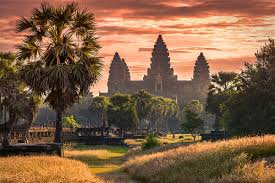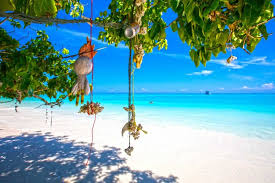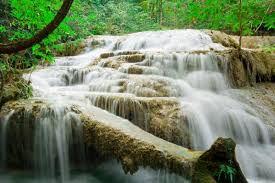Thailand is one of the world’s most popular tourist destinations,
attracting 15-20 million visitors a year. And this is with good reason,
as the many varied landscapes offer something for everyone – from the
hearty trekker to the adamant lounge lizard. From the infamous Golden
Triangle region in the far north to the tropical islands of the south,
Thailand offers a range of tourism options like no other country in
Asia.

The country is a constitutional monarchy, with a stable and mostly peaceful democracy which is periodically interrupted by a coup! The military maintains a powerful influence on politics, but the much respected King – who is head of state – wields the most influence, despite remaining out of politics. The country is 514,000 square-kilometres and border Malaysia to the south, Cambodia to the east, Laos to the north and Myanmar (Burma) to the west. Agriculture, tourism, manufacturing and assembly are its key industries with a healthy export sector.
The people are famous for their smile and welcoming easy-going attitude. Thailand’s identity has remained solid throughout modern history, despite its neighbouring countries being colonised by European powers. With the British in Burma and the French in Vietnam, Laos and Cambodia, Thailand’s avoidance of colonisation can be attributed to a series of clever rulers throughout this period who were able to keep foreign power at an arm’s length. As a result, it’s culture and character are less diluted by European influence.

From the 1970s onwards it ranked as one of the world’s fastest growing economies (nearly 10 per cent annually), but this has slow a bit of late. It has yet to achieve ‘Newly Industrialised Country’ status as a large welthy gap exists among its 64 million people. Poverty rates have shrunk dramatically and the average annual income is equivalent to US$9,200 (although much higher in Bangkok).
The monarchy is important to Thailand has been governed by a succession of kings since roughly the 13th century, with various monarchs governing from capitals starting in Sukhothai, then Ayutthaya, followed by Thonburi and now Bangkok. The current king Bhumibol has ruled for over 60 years, since the abolition of the absolute monarchy in 1932 that saw the draft of the country’s first constitution. All these historical locations still exist and the ruins of the ancient capitals should be high on any travel itinerary for the history buff.
Given that Thailand covers so much territory, there are many ethnic groups that fall under the jurisdiction of Thailand’s constitutional monarchy. One of the joys of travelling through Thailand is to observe the particularities and idiosyncrasies between the different provinces, observable through everything from language, clothing and cuisine. This includes groups with several main dialects, and the minority hilltribes who are found mainly in the north add colour and character to the national identity.
Thai food is understandably famous, and any aspirant will find cooking schools in most tourist-friendly locations. The only problem may be to find the particular ingredients upon returning to your home country. In any case, while here you can enjoy plentiful genuine, fiery, Thai food with regional variations.
Although Thailand is still technically a developing country, the tourist can expect to traverse the land with relative ease. The highway systems are excellent, with wide, sealed roads connecting all major cities. The trains can be slow, but the price is unbeatable and gives the traveller a chance to experience life among the locals. If you’re short on time or budget is not an issue, air travel is common and frequent to just about anywhere in the nation. Thailand has embraced the new trends of low-cost carriers, and aside from the national airline Thai Airways, you can jet around the country for half the price with Nok Air, AirAsia or One-Two-Go.

Bangkok is the main entry point for visitors and by far the biggest of the cities – a modern metropolis of eight million. It’s 300-year history is evident in the many impressive ancient sites on the tour itineraries. It is also well known for its racy, sometimes naughty, nightlife, plus shopping, business and as a melting pot of cultures from all over Asia. Opting to spend several days of your visit here is certainly worthwhile since there is so much to see and do.
If it’s the beaches you’re after, the most popular Andaman coast destinations like Koh Samui, Phuket, Koh Pha Ngan are serviced by numerous daily flights, trains and buses. Phuket is the most popular and best developed resort are with a wide range of activities and tourist sights. Nearby is the famous karst scenery of Krabi, which includes the world famous Phi Phi island. Koh Lanta is a quieter alternative, but this coast is full of islands to escape to.
On the Thai Gulf side, Samui is best loved for its ‘boutique resort’ experience. Close by is the backpacker favourite of Koh Phan Ngan with its wild full moon parties, and the diving mecca of Koh Tao is further afield. Within easy reach of Bangkok is Pattaya, more famous for its girlie bars than beaches, but further down the coast is the lovely white sand of tiny Koh Samet, and the eco-island of Koh Chang nearer Cambodia.
To follow the trail of history, it’s only a one-hour train journey from Bangkok to Ayutthaya, where the former glory of the capital can be seen by boat tour or by road. Continuing north, another popular stopping point is the even older capital of Sukhothai. The base for most visitors to the north is Thailand’s second largest city, Chiang Mai. From here the rest of the region is easily accessible. To the west, the mountain town of Pai is popular with bohemian types, and further towards Burma is Mae Hong Son, where relative isolation has kept tourism to a minimum.
The Golden Triangle is to the north and overnight tours are widely available. This can also be an entry point for further travel in to Laos. Chiang Rai has become a haven for trekking and nature, and the eastern province of Isarn offers yet another variant of the many cultural groups found in this diverse country.
No comments:
Post a Comment